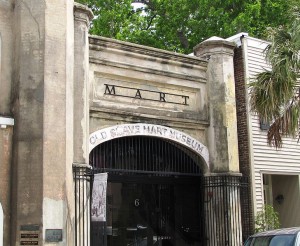On February 26, 1861 The New-York Times published an article by JASPER, a Charleston, South Carolina correspondent. Here’s an excerpt:
There is a place in Chalmers-street, with a neat iron open-work railing, protecting quite a graceful looking building. There was once — so I am told — an American flag waving from the roof. I have seen the Palmetto banner flaunting there in the incipient days of secession in November; then there was an emblematic Palmetto tree, which withered, and is now a dead stump. No matter. Everybody knows the place, the “Mart” of Charleston, where slaves are sold. This morning, at eleven, I called on THOMAS RYAN & SON, who wished to dispose of “Joe, 23 years old, a very likely negro man, good coachman and general house servant — sold for no fault — sale positive — cash, and purchaser to pay for bill of sale.” “Gentlemen,” said Mr. RYAN, “here is Joe; you observe he is sound, pleasant-faced, intelligent, and he is fully warranted. What will you give; $1,500, $1,400, $1,000. Why, gentlemen, you can examine for yourselves; Joe, step around. $900 is bid; ruinously cheap; $910, $20, $25, $30, $40, going, going, last call; gone at $940. Joe, there is your new master,” and Joe walked away, apparently quite content to bring $940. Mr. RYAN made a polite bow to myself and friends, and walked off the platform. I turned and saw in one corner a gentle-faced negro woman of a rich brown hue; she had wrapped in a shawl a wee babe, and clustered around her were two boys, one taller than herself, and a little girl, lighter than the mother. In fact, all the children were of different shades, which can be accounted for on physiological principles, apparent to all who choose to see; Mr. JAMES TUPPER, master in equity, toted these forth, terms cash. “Gentlemen,” blandly observed Mr. TUPPER, a mild-looking personage, “I offer to you five valuable slaves: BETSY ANN, the mother, a likely woman of thirty, her oldest son, JACK, sixteen, (BETSY ANN married young,) a good field hand; SAM, ten, a promising lad, good at horses and running errands; ARAMINTA, three, will make a nice lady’s maid, and the infant in arms, fat and healthy; I sell the lot together, you understand. Is $600 bid? a long pause; $500, thank you.” “I bid $400;” “Well, $400 it is.” So it went on in little sums, the mother “cuddling” her infant the while, and evidently ashamed to have it cry, so she suffocated it with shawls as negroes are apt to do. Finally, they were knocked down at $490 — $2,450 for the lot. BETSY ANN gave her babe another pat, and the family group, after bidding “old massa” good bye, made up to the new one. PRINCE, who was anything but a prince in appearance, was next offered. This fellow belonged to the genus blubber lip, a mere animal field hand. He had also lost three fingers in some negro shindy, so that although he was cracked up as a good workman, obliging, and only 27, he did not take, and was finally knocked down at $550, to some one who took pity on him. PRINCE shuffled off, evidently crest-fallen, and the crowd dispersed to talk cotton, secession, DAVIS, LINCOLN, the big raft, and Major ANDERSON’S death, a villainous hoax which many believed.
The photo is licensed under Creative Commons
You can read the entire article at The New York Times Archive. Jasper also writes about making cannonballs at Cameron’s:
Hundreds of swarthy sons of Vulcan, white as well as black, are turning out red-hot balls every second, and rolling them in the sand with their long iron forks as though they were so many marbles. Each ball has to pass through some ten pairs of hands before it can pass inspection, and as many more before it can do its murderous work.
You can read more about the Old Slave Mart née Ryan’s Mart at the National Park Service and at the City of Charleston. Apparently places like Ryan’s Mart became necessary after a citywide ban on public slave auctions in 1856.
If slavery was such a wonderful, if “peculiar”, institution, then why was there a ban on public auctions?

